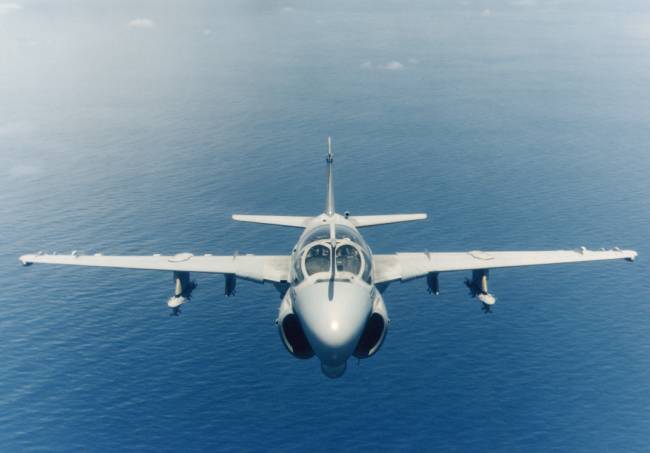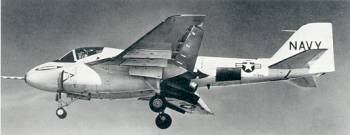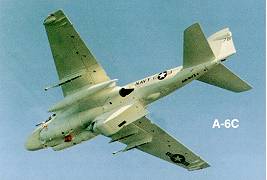
LIFE OF THE INTRUDER - By Hal Andrews
The Grumman A-6 Intruder could have never won a beauty contest.
With its engines and exhaust nozzles at mid-fuselage instead of
at the rear end, an ample cockpit canopy over the crew and a
bulbous radome nose, it was often described as being pointy at
the wrong end. But if a warplane should sport aggressive lines,
especially when carrying its lethal weapons, the Intruder
measured up with a beauty all its own.
The old adage "form follows function"
is appropriate in the Intruder's case. The Deputy Chief of Naval
Operations(Air Warfare) staff, the Bureau of Aeronautics(BUAER)
personnel who prepared the type specification for the airplane's
design, and the Grumman team who put together the winning
proposal all played a part in creating a configuration that
remained almost unchanged through 30 years of production.
Extensive internal changes and replacement of the original wings
with new composite construction made little difference in the
basic external appearance. Even its direct descendant, the EA-6B
Prowler, closely reflects its Intruder roots.
Beginnings
The Navy's Korean War experience, with no jet all-weather strike
capability and limited carrier air group night or all-weather
effectiveness, prompted research on avionics systems to overcome
this deficiency. By the mid-1950's, the Marine Corps defined its
need for an all-weather close air support airplane capable of
operating from the shortest possible expeditionary field runways.
Meanwhile, the Navy was introducing the first
of a new generation of jet carrier aircraft. These ranged from
the smallest attack jet, the A-4 Skyhawk, through various
fighters, to the long-range, heavy attack A-3 Skywarrior. Their
limitations, including no all-weather attack systems in the A-4
and the adverse impact of the A-3's large size in carrier
operations, led to studies showing that the application of new
avionics technology could produce carrier-based, all-weather
attack aircraft capable of long-range conventional or nuclear
strike missions flown at low terrain clearance altitudes below
enemy radar interception. The complex avionics would require a
second crewman for its effective use.
An operational requirement was established by
the office of the Chief of Naval Operations in 1956 for an
all-weather tactical airplane, combining the carrier attack
mission with the Marine's close-support, short-field capability.
Early in 1957, BUAER set forth the demanding mission and
operating performance requirements, along with appropriate
current design features, such as ejection seats for the aircrew.
Typically, various system components and equipment, such as the
engines, would be Navy procured and furnished and the proposed
contract would require the winning contractor to be responsible
for the totally integrated "weapon system." Eight
companies submitted 11 designs, ranging from turboprop-powered
designs to a supersonic jet and a vertical/short takeoff and
landing airplane.
 Grumman's proposal was selected in December of 1957,
with contract go-ahead for the now designated A2F-1 early in
1958. A unique feature of Grumman's design that played a role in
its selection was tilting exhaust nozzles on the mid-fuselage J52
engines. These exhaust outlets angled down 23 degrees for
short-field or carrier takeoffs and landings without producing
undesirable pitching moments.
Grumman's proposal was selected in December of 1957,
with contract go-ahead for the now designated A2F-1 early in
1958. A unique feature of Grumman's design that played a role in
its selection was tilting exhaust nozzles on the mid-fuselage J52
engines. These exhaust outlets angled down 23 degrees for
short-field or carrier takeoffs and landings without producing
undesirable pitching moments.
Initial design and wind tunnel testing led to
the mockup inspection in September 1958. Many changes in design
details would follow, but the overall airframe configuration was
well established. Development and construction of initial
aircraft was contracted in April 1959. The first aircraft(BuNo
147864) was rolled out in early 1960 and after ground testing at
Bethpage, N.Y., was transported to Calverton, N.Y., for its first
flight in April.
As flight testing proceeded, various changes
were made. The tilting exhaust nozzles didn't give enough
improvement to justify their weight, complexity and cost and were
eventually replaced with straight tail pipes. The vertical tail
shape was changed to correct predicted marginal spin recovery
characteristics, and the horizontal stabilizer was revised to a
slab which was moved aft to correct a hinge moment problem
without redesigning the fuselage attachment components. The speed
brakes were perforated to reduce buffeting and supplemented with
wing tip brakes for adequate dive-bombing effectiveness. Later,
the familiar fixed centerline in-flight refueling probe in front
of the windshield was added.
While airframe characteristics, including those
of the new nose gear tow catapulting system, were worked out, the
new avionics systems were a different story. Not only were there
difficulties with individual components, but the Digital
Integrated Attack and Navigation Electronics(DIANE) system was
almost unworkable and the unreliability of the components was
multiplied in the full system. A combined Grumman-Navy effort to
redesign components gradually brought hope of a system capable of
use for normal flight and led to solutions for its attack mode
problems. Meanwhile, the A2F-1 became the A-6A in 1962
designations.
By early 1963, it was possible to initiate
avionics Board of Inspection and Survey trials and at the same
time to deliver airplanes for replacement training to Attack
Squadron 42 at NAS Oceana, VA. The initial airplanes did not have
fully operational avionics, but were adequate to start instructor
pilot training. Initial day carrier qualifications were conducted
on USS Forrestal(CV-59) in July. Full system airplanes began to
arrive soon after and full training for both pilots and
bombardier navigators began. While avionics systems reliability
and maintenance continued to be a major concern, the first A-6
fleet squadron, VA-75, started its training.
Off to War
Soon after VA-75 completed its training with VA-42, the events of
August 1964 in the Tonkin Gulf led to the country's direct
military involvement in the Vietnamese War. By spring 1965,
preparations to take the new A-6's to war had progressed to the
point where VA-75 deployed with Carrier Air Wing 17 on USS
Independence(CVA-61) in May, flying its first missions against
North Vietnamese targets in July.
The A-6's initial combat record was anything
but auspicious; the Intruder suffered problems typical of a new
combat aircraft entering operational use and combat
simultaneously. Premature explosion of bombs soon after release
accounted for the first, and some subsequent, combat losses. This
and the unreliability and excessive maintenance of the complex
integrated avionics systems on which its all-weather bomber
capability depended were tackled head on. The first was solved by
fusing and wiring changes and by adding multiple ejector racks on
the five store stations. The second was more pervasive and was a
continuing problem. These technical aspects led to indecision on
operational mission assignments: whether to assign A-6 missions
based on large bomb-carrying capability or on all-weather
capabilities.
Over the next several years, as subsequent A-6
squadrons rotated through Seventh Fleet duty, both the technical
and operational problems reached resolution. Changes were made to
various DIANE components, and successful missions in monsoon
season weather dispelled planning for follow-on models with
reduced avionics systems capabilities. With less emphasis on
close support dive-bombing, the fuselage dive brakes were
disabled and locked closed, finally being replaced in production
by plain skin.
An electronic warfare EA-6A version was
developed for the Marines; 28 were converted from A-6As. In
combat, they operated from both shore bases and carriers. A
fuselage extension forward of the cockpit and an upper fin
antenna fairing housed the "electronic Intruder's"
countermeasures systems. Fuselage speed brakes were retained to
allow wing tip antennas.
 Other special-purpose versions, with systems optimized
for surface-to-air missile site attacks with standard
anti-radiation missiles and for around-the-clock attacks against
traffic on the Ho Chi Minh Trail, were built in smaller
numbers-19 A-6Bs and 12 A-6Cs, respectively. These were
integrated into regular A-6 squadrons. Interest in a tanker
version led to 1970 conversions of early A-6s by removing
avionics mission systems and installing a rear fuselage-mounted
hose and drogue system. The resulting KA-6Ds were also
operationally integrated into A-6 squadrons in small numbers.
Other special-purpose versions, with systems optimized
for surface-to-air missile site attacks with standard
anti-radiation missiles and for around-the-clock attacks against
traffic on the Ho Chi Minh Trail, were built in smaller
numbers-19 A-6Bs and 12 A-6Cs, respectively. These were
integrated into regular A-6 squadrons. Interest in a tanker
version led to 1970 conversions of early A-6s by removing
avionics mission systems and installing a rear fuselage-mounted
hose and drogue system. The resulting KA-6Ds were also
operationally integrated into A-6 squadrons in small numbers.
As avionics digital technology moved rapidly
forward, major replacement of DIANE components-including a single
multimode radar that could perform both the search and track
radar functions, and updated computers-resulted in a "new
insides" model, the A-6E, though it arrived too late to see
combat in Southeast Asia. To expedite transition to this greatly
improved systems capability, A-6As were converted to A-6Es.
Anywhere, Anytime
Production of new A-6Es and conversion of As to Es continued
through the late 1970s. A-6Bs and Cs were phased into the E
conversion line as capabilities similar to those of their
specialized systems became available. Changes continued to keep
the A-6Es up to date. With development of the full Target
Recognition and Attack Multisensor(TRAM) system using a small
turret-mounted forward-looking infrared sensor, a full update
package was established for production, resulting in the A-6E
TRAM configuration. Its TRAM turret under the radome and a ram
air inlet on the port side of the upper fuselage for additional
aft bay systems cooling were among the few external changes made
to the Intruders. Internally, a new Carrier Airborne Inertial
Navigation System(CAINS) and new universal missile wiring and
pylons were of equal importance to the TRAM in crew effectiveness
and combat capability.
The major concern in the 1980s was the the
increasing problem of older A-6s using up their wing fatigue
life. With the objective of extending the service life of the
A-6Es, the Navy sought the construction of new, longer life
wings, awarding the contract to Boeing for its proposed
composite-construction wings.
At the same time, early studies leading toward
a stealthy "advanced technology attack" replacement for
the A-6 suggested a significantly improved A-6 would be a useful
interim development. A contract was signed with Grumman for five
development A-6Fs in 1984. These would have the composite wings,
a revolutionary radar system and new GE F404 engines. The engines
would be the same as those in the F/A-18 Hornet, except without
the afterburners. With other changes to enhance survivability,
the A-6F would mark a major improvement in the A-6's
effectiveness.
The first A-6F flew in August of 1987, the
second later that year. By the time the third flew in the summer
of 1988, funding constraints ended the program, except for
avionics testing as a possible future upgrade.
Meanwhile, Intruders had seen further combat:
over Lebanon in 1983 and more effectively against both Libyan and
Iranian vessels and targets in 1986 and 1988, respectively.
Intruders remained mainstays of the fleet, even as their
contemporaries, the F-4 Phantom and A-7 Corsair II, were being
replaced by the F/A-18.
 On 17 January 1991, Desert Shield became Desert Storm,
and Intruder squadron aircrews were once again in combat. Loss of
two Navy A-6s in the first day's action led to tactics revisions,
and only one more A-6 was lost to enemy ground fire during the
remaining nearly six weeks until the 27 February cease fire.
KA-6Ds and A-6Es using buddy tanker stores were part of an
extensive aerial refueling force. Two shore-based Marine A-6
squadrons flew all-weather deep strike and later close air
support missions without losses.
On 17 January 1991, Desert Shield became Desert Storm,
and Intruder squadron aircrews were once again in combat. Loss of
two Navy A-6s in the first day's action led to tactics revisions,
and only one more A-6 was lost to enemy ground fire during the
remaining nearly six weeks until the 27 February cease fire.
KA-6Ds and A-6Es using buddy tanker stores were part of an
extensive aerial refueling force. Two shore-based Marine A-6
squadrons flew all-weather deep strike and later close air
support missions without losses.
Just before Desert Storm, the A-12 program was
canceled due to cost growth. The various efforts for an A-12
replacement failed to find an affordable approach, and with the
collapse of the Soviet Union more focus was placed on U.S.
military expenditures. Potential reductions in total operational
squadrons brought an end to A-6E procurement, and deliveries
ended in January 1992. Navy operational units underwent major
reductions in 1993 as part of post-cold war cutbacks. Each
deployed carrier's air wing still included an A-6E squadron;
however, a decision was made to retire the last A-6Es in 1997.
Following final deployments of the last two
squadrons, VAs 196 and 75 were disestablished on 28 February and
31 March, 1997, respectively. One hundred composite wing
Intruders went to the Aerospace Maintenance and Regeneration
Center(AMARC), Davis-Monthan AFB, Arizona., for storage, while
mostly older metal and composite-winged versions went to various
museum and display locations.
The Intruder served with
distinction as the Navy's primary medium-attack aircraft for 34
years-winning our respect and our hearts.



 Other special-purpose versions, with systems optimized
for surface-to-air missile site attacks with standard
anti-radiation missiles and for around-the-clock attacks against
traffic on the Ho Chi Minh Trail, were built in smaller
numbers-19 A-6Bs and 12 A-6Cs, respectively. These were
integrated into regular A-6 squadrons. Interest in a tanker
version led to 1970 conversions of early A-6s by removing
avionics mission systems and installing a rear fuselage-mounted
hose and drogue system. The resulting KA-6Ds were also
operationally integrated into A-6 squadrons in small numbers.
Other special-purpose versions, with systems optimized
for surface-to-air missile site attacks with standard
anti-radiation missiles and for around-the-clock attacks against
traffic on the Ho Chi Minh Trail, were built in smaller
numbers-19 A-6Bs and 12 A-6Cs, respectively. These were
integrated into regular A-6 squadrons. Interest in a tanker
version led to 1970 conversions of early A-6s by removing
avionics mission systems and installing a rear fuselage-mounted
hose and drogue system. The resulting KA-6Ds were also
operationally integrated into A-6 squadrons in small numbers.  On 17 January 1991, Desert Shield became Desert Storm,
and Intruder squadron aircrews were once again in combat. Loss of
two Navy A-6s in the first day's action led to tactics revisions,
and only one more A-6 was lost to enemy ground fire during the
remaining nearly six weeks until the 27 February cease fire.
KA-6Ds and A-6Es using buddy tanker stores were part of an
extensive aerial refueling force. Two shore-based Marine A-6
squadrons flew all-weather deep strike and later close air
support missions without losses.
On 17 January 1991, Desert Shield became Desert Storm,
and Intruder squadron aircrews were once again in combat. Loss of
two Navy A-6s in the first day's action led to tactics revisions,
and only one more A-6 was lost to enemy ground fire during the
remaining nearly six weeks until the 27 February cease fire.
KA-6Ds and A-6Es using buddy tanker stores were part of an
extensive aerial refueling force. Two shore-based Marine A-6
squadrons flew all-weather deep strike and later close air
support missions without losses. 